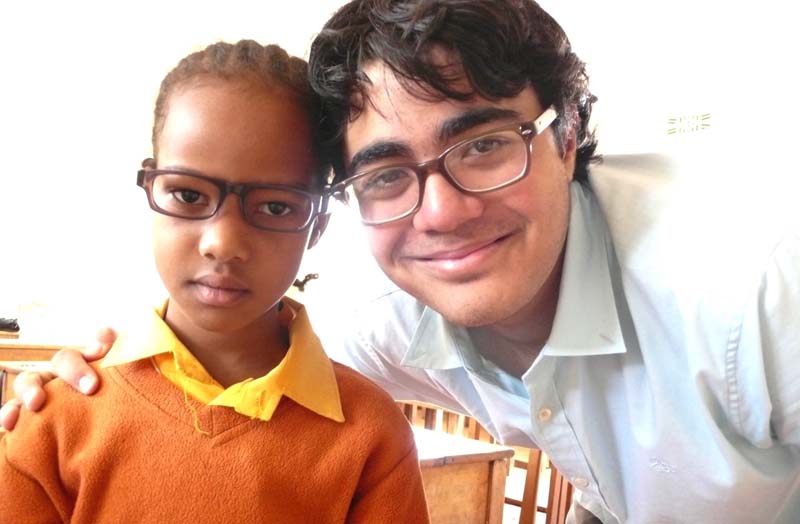The Hidden Crisis: How Malnourishment and Ignorance Are Leading to Vision Loss in Africa

For millions of people across Africa, clear vision is a distant dream. Many children are unable to read the blackboard, farmers struggle to tend their crops, and workers lose their jobs—not because of age or disease, but because of poor nutrition and lack of awareness about eye health.
What’s heartbreaking is that many of these cases of vision loss are completely preventable. A simple diet change or a pair of eyeglasses could restore sight, yet millions continue to suffer in silence.
At First Sight, we are working to change this reality. By providing affordable eyeglasses and spreading awareness, we are ensuring that vision loss doesn’t keep people from living productive, fulfilling lives.
The Link Between Malnutrition and Vision Loss
Vitamin Deficiencies: A Silent Cause of Blindness
Most people don’t realize that what we eat directly impacts how well we see. But for many families in underdeveloped countries, access to nutrient-rich foods is a luxury. Instead, their diets are often limited to low-nutrient, starchy foods like maize and cassava, which fill the stomach but do not provide essential vitamins for eye health.
Vitamin A Deficiency (VAD): One of the biggest causes of blindness in children. A lack of Vitamin A leads to night blindness, corneal damage, and, in severe cases, complete vision loss.
Zinc Deficiency: Prevents the body from properly absorbing Vitamin A, worsening eyesight over time.
Iron Deficiency: Leads to optic nerve damage, causing blurred vision and eye fatigue.
Omega-3 Deficiency: Weakens the retina, increasing the risk of eye diseases like macular degeneration.
The Numbers Speak for Themselves
According to the World Health Organization (WHO), nearly 500,000 children become blind every year due to Vitamin A deficiency alone.
Many of these children won’t survive beyond a year because their weakened immune systems make them vulnerable to other diseases.
This suffering is entirely preventable—if only people had access to the right nutrition and knowledge.
Ignorance and Lack of Awareness: A Second Crisis
Even when people start losing their vision, most don’t seek help—because they don’t know they need it.
- Poor Vision is Left Undiagnosed
In rural villages, eye doctors don’t exist. Many people have never had an eye exam in their entire lives. So when their vision starts to fail, they assume it’s normal or unchangeable.
Children drop out of school because they can’t read the board.
Farmers lose their ability to work and support their families.
Elders become completely dependent on others for survival.
And the worst part? They never realize a simple pair of glasses could fix their problem.
- Myths and Stigma Around Eyeglasses
Even when glasses are available, some people refuse to wear them due to harmful myths:
“Wearing glasses makes your eyesight worse.” (False)
“Only rich people wear glasses.” (False)
“Glasses are a sign of weakness.” (False)
These dangerous beliefs keep people trapped in a cycle of avoidable blindness.
- No Access to Eye Care
Even if someone wants to get their vision checked, eye care is often out of reach.
No eye clinics nearby
No trained eye doctors
High costs for exams and glasses
In many areas, the nearest eye doctor is hundreds of miles away. For most families, traveling for an eye exam is simply impossible.
The Consequences of Poor Vision
Without proper eye care, the impact on individuals and communities is devastating:
Children Fall Behind in School
- 80% of learning is visual—if a child can’t see, they can’t learn.
- Many are labeled as “slow learners” or drop out entirely.
- Without an education, they are trapped in the cycle of poverty.
Adults Lose Their Jobs
- Farmers, artisans, and shopkeepers struggle to work.
- Many lose their income and become dependent on others.
- Entire communities suffer when capable workers lose their vision.
Elders Lose Their Independence
- Everyday tasks like cooking, reading, and recognizing faces become impossible.
- Many become socially isolated and depressed.
All of this is preventable—with a simple pair of eyeglasses.
How First Sight is Restoring Vision and Hope
At First Sight, we refuse to accept a world where millions of people lose their vision simply because they lack access to nutrition and eye care.
- Providing Instant, Affordable Eyeglasses
Unlike traditional solutions that require:
Expensive equipment
Weeks of waiting for glasses
Trained professionals
Our portable, no-electricity-needed First Sight kits provide:
On-the-spot vision screening
Prescription glasses in under 10 minutes
A simple system that requires no formal training
- Raising Awareness About Eye Health
We work with local partners, schools, and community leaders to:
Educate families on the importance of Vitamin A and other essential nutrients
Distribute fortified foods and supplements
Teach communities how early detection can prevent blindness
- Reaching the Most Remote Areas
Where there are no eye clinics, no doctors, and no resources—First Sight is there.
Rural villages
Conflict-affected areas
Communities with no access to healthcare
How You Can Help
This crisis is solvable—but we need your help.
Donate – Your support provides life-changing eyeglasses for those in need.
Spread Awareness – Share this blog to educate others.
Partner With Us – Help First Sight expand vision care to the most underserved regions.
Together, we can bring the world into focus for those who need it most.
Conclusion
The rise of eye problems due to malnutrition and ignorance is not an unsolvable issue—it’s a preventable tragedy.
By providing eyeglasses, education, and access to proper nutrition, we can restore sight, transform lives, and create a future where no one is left in the dark.
At First Sight, we believe in a world where every child can see their future clearly and every adult can work with dignity.
Join our mission today at https://firstsight.org

